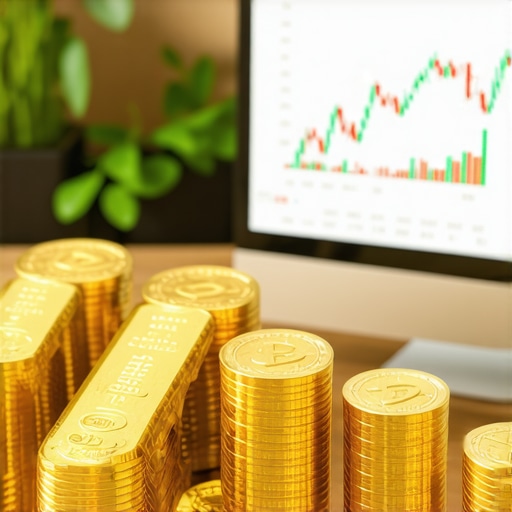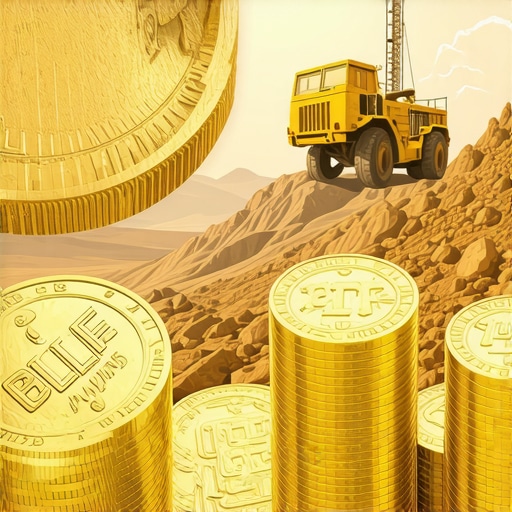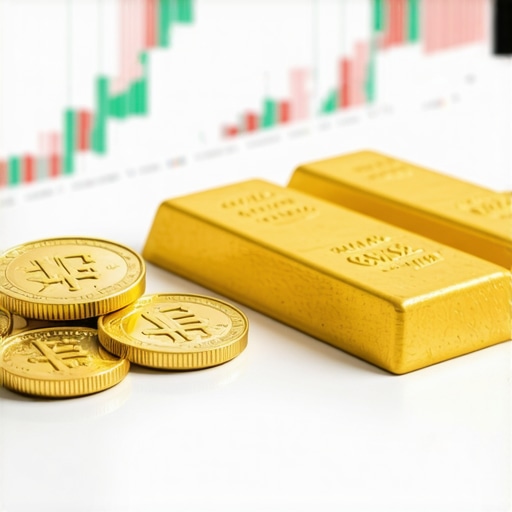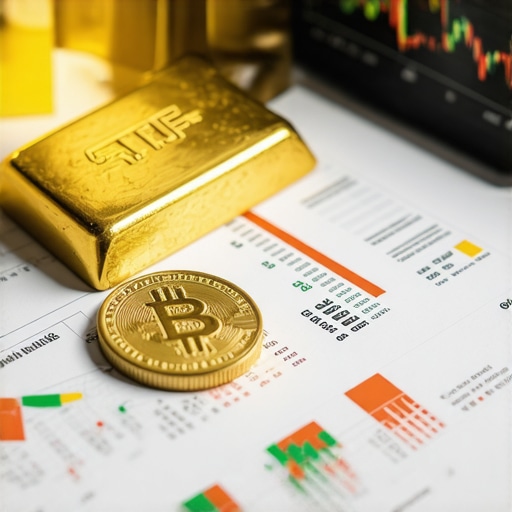Gold Fever: Why Everyone’s Suddenly Obsessed with This Shiny Metal
Let’s face it — gold has always been the diva of the investment world. Blink and you might miss its glittering rise or the occasional dip that sends investors into a frenzy. But why does this precious metal continue to dazzle portfolios and conversations alike? Whether you’re a seasoned investor or just dipping your toes into the golden waters, understanding the types of gold investments and their quirks is your ticket to savvy wealth building.
From Coins to ETFs: The Gold Investment Buffet
When it comes to gold, you’re not just picking up a metal; you’re selecting a style, a strategy, and sometimes, a story. The most popular avenues are physical gold (like bars and coins), gold ETFs (Exchange-Traded Funds), and even gold mining stocks. Each has its own charm and challenge. Physical gold offers tangible security but can be a headache to store and insure. ETFs deliver liquidity and ease but tie you to market whims and management fees. Mining stocks add a layer of risk and reward since you’re betting on company performance, not just metal prices.
Is Physical Gold Still the Ultimate Safe Haven in 2025?
There’s an undeniable romance to holding a gold coin or bar in your hand — it’s pure, unadulterated wealth, immune to the digital glitches or banking crises. But let’s not sugarcoat it: storage and security costs can nibble away at your returns. Plus, authenticity and dealer trustworthiness are vital; a misstep here could turn your treasure into fool’s gold. For beginners, a step-by-step guide to buying gold bars can be a lifesaver.
On the flip side, gold ETFs provide a hassle-free way to ride gold’s rollercoaster without having to tuck bars under your mattress. But beware — they expose you to market dynamics and sometimes hefty fees that can eat into your gains. For those pondering this route, the article on best gold ETFs and mutual funds for consistent dividend income breaks down the options beautifully.
Why Not Share Your Golden Insights?
Have you ventured into gold investments? Which type stole your heart (and hopefully your profits)? Drop your thoughts or experiences below — sharing is caring in the investment community, after all!
For a deeper dive into how gold demand trends are shaping prices and opportunities, check out the comprehensive analysis at World Gold Council’s Gold Demand Trends 2024, a goldmine of expert insights.
Gold’s Role in Diversified Portfolios: Balancing Risk and Reward
Investors often grapple with the challenge of balancing their portfolios, and gold frequently emerges as a pivotal asset class to manage risk. Its historical resilience during economic downturns makes it a favored hedge against volatility. However, the intricacies of incorporating gold—whether through physical bars, ETFs, or mining stocks—are nuanced. Understanding how each form interacts with broader portfolio dynamics is essential for optimizing returns while minimizing exposure to systemic shocks.
Physical gold offers a tangible asset that acts as a safe haven amid market turbulence, but the costs and logistics of storage and security can reduce net gains. Conversely, gold ETFs provide liquidity and ease of trade but require careful selection to avoid excessive management fees and tracking errors. Mining stocks, meanwhile, offer leverage to gold price movements but introduce company-specific and geopolitical risks that can complicate risk profiles.
Decoding Market Signals: How Economic Indicators Shape Gold Prices in 2025
Gold prices in 2025 are not solely dictated by supply and demand; macroeconomic indicators wield considerable influence. Inflation rates, currency strength, interest rates, and geopolitical tensions all interplay to create price momentum or volatility. For instance, rising inflation usually propels investors towards gold as a store of value, whereas a strengthening U.S. dollar might suppress gold prices due to its inverse relationship.
Moreover, central bank policies and their gold buying behaviors have become increasingly transparent and impactful. Recent trends highlight strategic gold accumulation by emerging market central banks aiming to diversify reserves. This institutional demand can serve as a stabilizing force, mitigating some volatility caused by speculative trading.
Can Strategic Allocation of Gold Enhance Portfolio Resilience Against Inflation?
This question strikes at the core of contemporary investment strategy. Allocating gold strategically, whether through physical assets or financial instruments like ETFs, can indeed buffer portfolios against inflationary pressures. However, the optimal allocation depends on individual risk tolerance, investment horizon, and market conditions. Investors must evaluate the trade-offs between liquidity, cost, and security to tailor gold exposure that complements their broader financial goals.
For those interested in a comprehensive breakdown of these strategies and practical tips for beginners, the article Investing in Gold for Beginners: Avoid These Costly Mistakes offers invaluable guidance.
Leveraging Expert Insights to Navigate Gold’s Complex Landscape
Industry experts emphasize the importance of continuous market analysis to capture emerging trends and avoid pitfalls. According to the World Gold Council’s Gold Demand Trends 2024, jewelry demand remains a critical driver of gold consumption, while technological applications and investment demand add layers of complexity. Staying informed about these multifaceted demand drivers empowers investors to make more nuanced decisions aligned with market realities.
Engage with the community by sharing your own gold investment experiences or questions in the comments below. Your insights could spark valuable discussions and contribute to collective wisdom.
Unlocking the Hidden Layers: Advanced Analytical Techniques to Forecast Gold Price Movements
While many investors track gold prices through simple supply-demand metrics and inflation hedging narratives, seasoned experts dive deeper into market microstructure and quantitative models. Techniques such as time-series analysis, machine learning algorithms, and sentiment analysis of geopolitical news offer nuanced predictive power beyond conventional wisdom. For example, integrating real-time data on central bank gold reserves, currency fluctuations, and futures market positioning can reveal inflection points before mainstream recognition.
Moreover, understanding the behavioral finance elements—how investor psychology, herd behavior, and risk-on/risk-off sentiment influence gold flows—adds a sophisticated layer to price forecasting. For instance, the decoupling of gold prices from traditional safe-haven status during short-lived risk rallies demands a recalibrated model that incorporates global liquidity and credit conditions.
Engaging with advanced research like the World Gold Council’s report on gold price forecasting methodologies equips investors with cutting-edge tools to anticipate market dynamics.
Innovative Gold Investment Vehicles: Beyond ETFs and Physical Bullion
The gold investment landscape is evolving rapidly. Beyond the familiar terrain of physical gold and ETFs, sophisticated investors now explore gold-linked derivatives, structured products, and blockchain-based gold tokens. These instruments offer tailored exposure with enhanced liquidity, leverage options, and fractional ownership, all while introducing novel risk profiles.
For instance, gold futures and options enable strategic hedging and speculative plays aligned with macroeconomic views. Meanwhile, gold-backed digital tokens on decentralized finance platforms provide transparency and ease of transfer without traditional custody constraints. However, the regulatory environment remains fluid, demanding vigilant due diligence.
Understanding these vehicles’ mechanics, counterparty risks, and fee structures is imperative. As one example, the rise of gold ETFs with dividend-like yields from mining equities or royalty streams presents hybrid models blending income generation with precious metal exposure.
How Can Blockchain Technology Revolutionize Gold Ownership and Trading?
Blockchain’s immutable ledger and tokenization processes promise to democratize gold investing by enabling fractional ownership, instant settlement, and enhanced transparency. This reduces barriers for retail investors and institutional participants alike, potentially transforming liquidity dynamics and price discovery.
However, challenges such as regulatory acceptance, custodial integrity of the underlying physical gold, and cybersecurity risks accompany these innovations. Investors should critically evaluate gold token platforms’ auditability and redemption mechanisms before committing capital.
For a detailed exposition on blockchain’s impact on gold markets, consult the Investopedia Blockchain Gold Token article.
Risk-Adjusted Portfolio Construction: Leveraging Gold for Tailored Financial Resilience
Integrating gold into portfolios is less about blanket allocations and more about dynamic, risk-adjusted positioning. Sophisticated portfolio managers use scenario analysis and stress testing to calibrate gold exposure according to macroeconomic cycles, interest rate trajectories, and geopolitical risk indices.
For example, during early-stage inflationary phases, gold’s correlation with real assets may bolster portfolio resilience, while in deflationary shocks, its liquidity and capital preservation traits become paramount. Tactical shifts between physical bullion, mining stocks, and ETFs can optimize risk-return profiles.
Moreover, incorporating gold’s role in multi-asset portfolios requires understanding its interaction with bonds, equities, and alternative assets under varying market regimes. Advanced tools such as Monte Carlo simulations and factor-based models aid in these complex allocation decisions.
Invitation to the Community: Share Your Cutting-Edge Approaches and Experiences
Are you leveraging novel analytical frameworks or emerging gold instruments in your investment approach? How do you navigate the evolving regulatory and technological landscape? Your insights can enrich this dialogue and help fellow investors forge more informed strategies.
Contribute your thoughts and questions below, and let’s elevate our collective expertise on gold investing in 2025 and beyond.
Harnessing Sentiment Analysis and Behavioral Finance to Predict Gold Price Swings
In the labyrinthine world of gold investing, traditional metrics like supply-demand balance and inflation hedging tell only part of the story. Cutting-edge investors are increasingly turning to sentiment analysis tools that parse geopolitical developments, market chatter, and investor psychology to anticipate price movements. This nuanced approach uncovers patterns in herd behavior and risk appetite shifts that often precede sharp gold price corrections or rallies.
For example, a surge in risk-off sentiment during geopolitical tensions typically propels gold as the ultimate safe haven, but fleeting risk rallies can temporarily decouple gold prices from their usual inverse correlation with equities. Incorporating behavioral finance theories into forecasting models can enhance timing and positioning accuracy—tools adept at tracking social media sentiment, news flows, and futures positioning provide invaluable early warnings.
Exploring these advanced techniques further? The proven gold trading techniques offer expert strategies blending quantitative and qualitative analyses for superior market navigation.
Unlocking Gold’s Potential Through Sustainable and Ethical Investment Lenses
As environmental, social, and governance (ESG) considerations gain prominence, gold investors face new criteria beyond price and liquidity. Mining companies with robust sustainability practices and ethical sourcing are becoming increasingly attractive, aligning financial goals with conscientious stewardship. This trend reshapes gold mining stock valuations and investor preferences, creating opportunities in firms pioneering low-impact extraction and community engagement.
Moreover, physical gold investors are scrutinizing provenance and certification more rigorously, seeking assurance that their assets reflect responsible supply chains. This evolution not only affects market dynamics but also incentivizes transparency and accountability across the gold industry.
Can ESG Integration in Gold Mining Stocks Deliver Superior Risk-Adjusted Returns?
The intersection of ESG factors and gold investment performance presents a compelling research frontier. Early evidence suggests companies with strong ESG profiles often exhibit resilience against regulatory shocks and reputational risks, potentially translating into more stable cash flows and valuations. However, investors must balance ESG enthusiasm with rigorous financial analysis to avoid greenwashing pitfalls.
For a detailed guide on evaluating mining stocks through this dual lens, visit How to Evaluate Gold Mining Stocks for Maximum Returns, which helps investors navigate this complex landscape.
Decoding the Ripple Effects: How Emerging Technologies Shape Gold Demand and Supply
Technological innovation continues to sculpt gold’s demand trajectory beyond jewelry and investment. Applications in electronics, medical devices, and even green technologies like solar panels increasingly drive industrial consumption. Simultaneously, advancements in mining technology—such as automation, AI-assisted exploration, and improved ore processing—are optimizing supply chains and potentially moderating production costs.
These dynamics complicate traditional supply-demand equations, requiring investors to monitor tech sector trends alongside macroeconomic indicators. For those eager to understand these multifaceted influences, the Understanding Global Gold Demand and Its Market Impact in 2025 article offers an authoritative perspective.
Invitation to Share: What Cutting-Edge Strategies Are Shaping Your Gold Investment Approach?
Whether you’re leveraging sentiment analytics, integrating ESG considerations, or tracking technological influences on gold markets, your expertise is invaluable. How do you incorporate these advanced insights into your portfolio construction? What innovative tools or research sources have yielded the most actionable intelligence? Share your experiences and questions below to foster a vibrant, informed community of gold investors navigating the complexities of 2025 and beyond.
Expert Insights & Advanced Considerations
The Nuanced Role of Gold in Dynamic Portfolio Construction
Gold’s function transcends mere inflation hedging; it serves as a dynamic risk management tool adaptable to shifting macroeconomic environments. Sophisticated investors tailor allocations among physical bullion, ETFs, and mining stocks based on scenario analyses, optimizing for factors like liquidity needs, geopolitical risks, and interest rate cycles. This fluid approach enhances portfolio resilience beyond static gold weightings.
Integrating Behavioral Finance and Sentiment Analytics Enhances Market Timing
Traditional fundamental drivers only tell part of gold’s story. Cutting-edge investors incorporate sentiment analysis of geopolitical events, social media trends, and futures positioning to anticipate price inflections ahead of conventional indicators. This blend of quantitative and qualitative data unlocks a deeper understanding of herd behavior and risk-on/risk-off dynamics critical for tactical gold trading.
ESG Factors Reshape Gold Mining Investment Landscapes
Environmental, social, and governance criteria now significantly influence mining stock valuations and investor preferences. Companies with transparent, ethical sourcing and sustainable operations tend to demonstrate greater resilience to regulatory pressures and reputational risks, potentially offering superior risk-adjusted returns. However, discerning genuine ESG commitment from greenwashing demands rigorous due diligence.
Blockchain and Digital Gold Tokens: Revolutionizing Ownership and Liquidity
The advent of blockchain-based gold tokens introduces fractional ownership, instant settlement, and enhanced transparency, democratizing access for retail and institutional investors alike. Yet, challenges around regulatory acceptance, custodial security, and platform auditability require cautious evaluation before integration into portfolios.
Advanced Quantitative Models Unlock Deeper Price Forecasting Potential
Beyond classical supply-demand frameworks, time-series analyses, machine learning algorithms, and geopolitical sentiment models provide nuanced predictive capabilities. These methods enable anticipation of inflection points by integrating real-time central bank activity, currency fluctuations, and futures market positioning, offering a competitive edge in volatile markets.
Curated Expert Resources
World Gold Council’s Gold Demand Trends 2024: An authoritative resource delivering comprehensive analysis of demand drivers across jewelry, investment, and technology sectors, crucial for understanding underlying market momentum. (Explore here)
Investing in Gold for Beginners: Avoid These Costly Mistakes: A practical guide for navigating common pitfalls in physical and financial gold investments, ideal for refining foundational strategies. (Read more)
Proven Gold Trading Techniques to Enhance Your Market Success: This resource blends quantitative and qualitative approaches, emphasizing sentiment analysis and behavioral finance insights to improve timing and positioning. (Discover strategies)
Understanding Global Gold Demand and Its Market Impact in 2025: Investigates technological, industrial, and ESG factors shaping gold supply and demand, providing a multifaceted market perspective. (Learn more)
How to Evaluate Gold Mining Stocks for Maximum Returns: Combines financial analysis with ESG considerations to guide selection of mining equities with superior risk-adjusted profiles. (Read guide)
Final Expert Perspective
In 2025, gold investing demands a sophisticated blend of traditional wisdom and innovative analytical frameworks. The metal’s enduring allure lies not just in its intrinsic value but in how investors harness advanced portfolio construction techniques, behavioral insights, ESG integration, and emerging digital instruments to navigate a complex, evolving landscape. Recognizing gold’s multifaceted roles—from a tangible safe haven to a tokenized asset—empowers investors to sculpt resilient, adaptive strategies aligned with their financial objectives.
Engage actively with the wealth of expert knowledge available, refine your approach through continuous learning, and contribute your insights to the vibrant gold investment community. For foundational tactics, advanced forecasting, and nuanced demand analysis, explore the resources linked above and deepen your mastery of gold’s compelling story in today’s market.











I find the discussion around physical gold versus ETFs particularly relevant in today’s market. Personally, I started with physical gold because I appreciated the tangible security, but I quickly realized the costs of storage and insurance added up faster than I expected. On the other hand, ETFs are undeniably more convenient, especially for liquidity, but they do expose you to market and management fees that can eat into returns over time. Has anyone here integrated both approaches into a diversified strategy? For example, holding physical gold for safety and ETFs for liquidity? Additionally, with the rise of blockchain-based gold tokens, it seems like a promising way to get more fractional ownership and transparency. I’d love to know what others think about these digital assets and how they compare to traditional holdings. Do you see blockchain gold tokens replacing some of the physical or ETF holdings in the future, or will they serve more as complementary tools? Insights on balancing these options would be really valuable for those of us trying to navigate the evolving gold landscape.